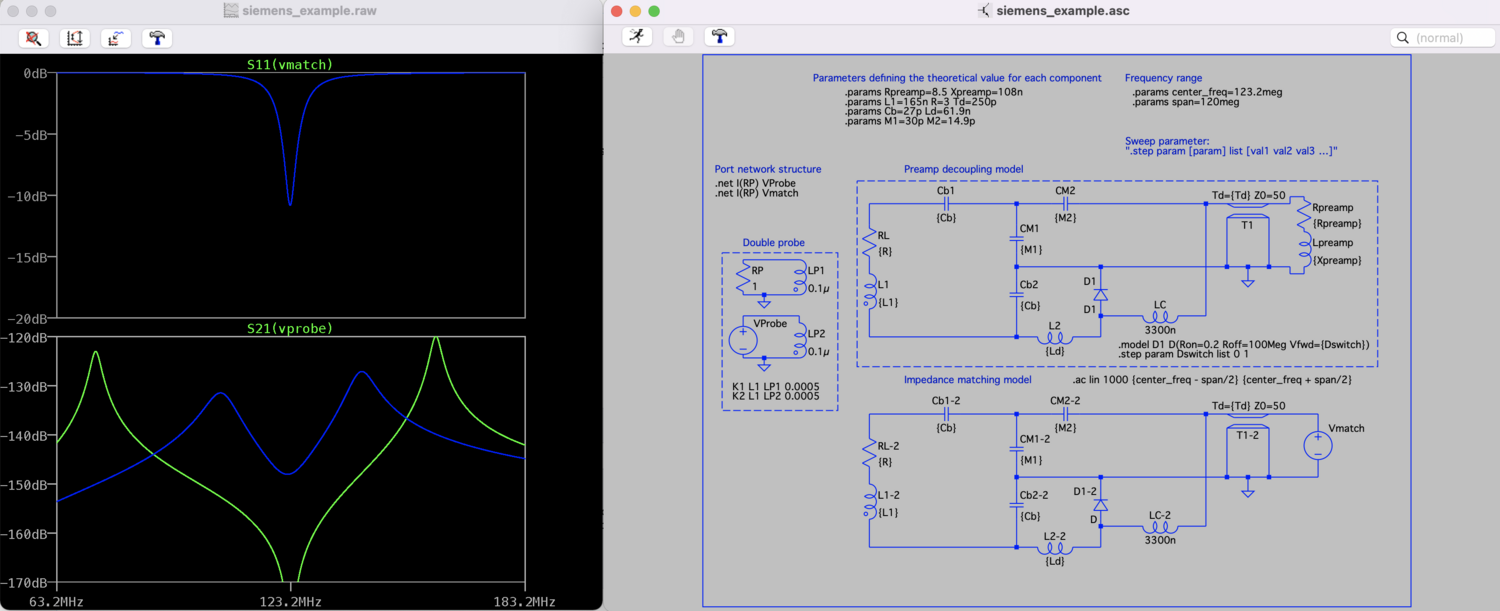Difference between revisions of "LT-SPICE simulations of RF receive coil element tuning and matching"
| Line 2: | Line 2: | ||
| − | We have developed a simple LT-SPICE model for simulating MRI RF receive element tuning and matching circuits to pick component values before tuning up a test loop in the lab. There are two coil models. The first is used to assess preamp decoupling and PIN diode detuning performance. The second model assess the impedance match looking toward the coil from the preamp. The component values can be set using variables to update both coil models simultaneously. | + | We have developed a simple LT-SPICE model for simulating MRI RF receive element tuning and matching circuits to pick component values before tuning up a test loop in the lab. There are two coil models. The first is used to assess preamp decoupling and PIN diode detuning performance. This model uses a "dummy double probe" with two inductive ports that are lightly coupled to the coil loop allowing for a two-port S21 measurement of the coil resonance. By modifying the model to remove the preamp, you can also look at the open-circuit resonance. The second model assess the impedance match looking toward the coil from the preamp. |
| + | |||
| + | The component values can be set using variables to update both coil models simultaneously. The model includes a plot file that should automatically show S21 with the PIN diode ON, S21 with PIN diode off (just change the frequency axis as needed). | ||
How to set up a basic coil model: | How to set up a basic coil model: | ||
Revision as of 21:09, 24 February 2022
We have developed a simple LT-SPICE model for simulating MRI RF receive element tuning and matching circuits to pick component values before tuning up a test loop in the lab. There are two coil models. The first is used to assess preamp decoupling and PIN diode detuning performance. This model uses a "dummy double probe" with two inductive ports that are lightly coupled to the coil loop allowing for a two-port S21 measurement of the coil resonance. By modifying the model to remove the preamp, you can also look at the open-circuit resonance. The second model assess the impedance match looking toward the coil from the preamp.
The component values can be set using variables to update both coil models simultaneously. The model includes a plot file that should automatically show S21 with the PIN diode ON, S21 with PIN diode off (just change the frequency axis as needed).
How to set up a basic coil model:
- Coil loop inductance is specified by "L1". Adjust tuning and matching capacitor values (or add more matching elements as needed).
- Specify the input impedance of the preamp using "Rpreamp and Lpreamp".
- Set the desired length of cable (and cable impedance)
Click here to download LT-SPICE model: https://rflab.martinos.org/images/5/5d/Siemens_example_spice.zip
